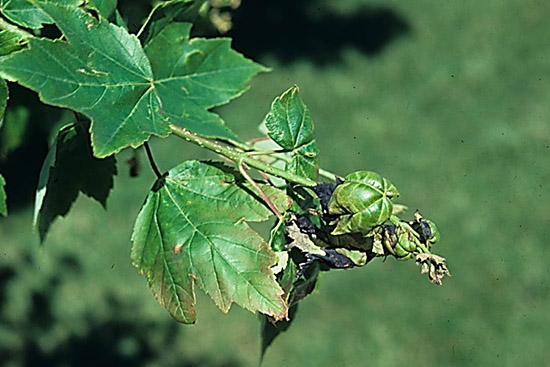Issue 8, June 15, 2015
Potato Leafhopper
Potato leafhoppers are actively feeding with damage being obvious on red maple. These leafhoppers attack oak, maple, red mulberry, red bud, cottonwood, birch, apple, dogwood, hawthorn, wafer ash, euonymus, black locust, and cherry.
Red maple is most severely damaged. The expanding leaves at branch tips are curled and stunted, and they are mottled with light green, red, and brown. Leaf edges and entire leaves may turn brown or black. Stem growth is greatly reduced. Annual growth can be reduced from a couple of feet to a couple of inches. Thus, this can be a serious nursery pest.

Potato leafhopper damage on red maple.
Overall, the damage looks similar to 2,4-D injury. Damage is heaviest at the top of the tree. On other host species, leaves may be misshapen, have brown areas, show early fall color, or have stippling (light dots).
Damage to winged euonymus (burning bush) appears as reddish areas on leaves in the summer well before it would occur as fall color.
Potato leafhopper adults are wedge-shaped, green, and about 1/8 inch long. They fly readily from foliage when approached and are very migratory, making it difficult to find the insects on damaged foliage. They are strongly attracted to lights at night and are small enough to go through the mesh of window screening. You'll probably recognize these pests as the little green bugs that fly around the newspaper or book you are trying to read during summer evenings indoors.
As nymphs, potato leafhoppers are similar in appearance to adults but are smaller and cannot fly. Even so, nymphs are quite active and will walk sideways to the other side of the leaf when it is inspected, making them difficult to see. Frequently, the only insect parts that can be found are the transparent, cast skins left behind by the molted nymphs.
Treatment at this time is effective in preventing additional damage through the growing season. Acetamiprid (TriStar), carbaryl (Sevin), clothianidin (Arena), thiamethoxam (Meridian), and labeled pyrethroids are effective. Retreatment every two weeks (carbaryl) or month (pyrethroids) may be needed as long as new leaves are being produced. (Phil Nixon)
Author:
Phil Nixon